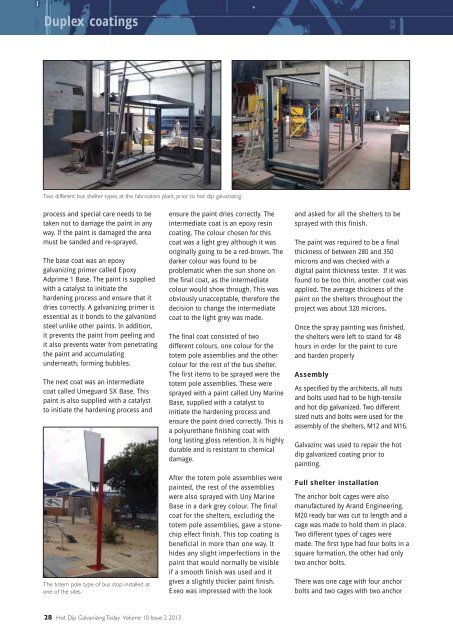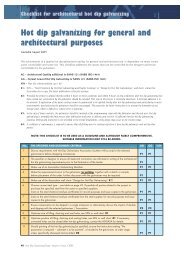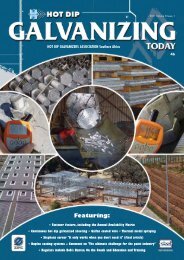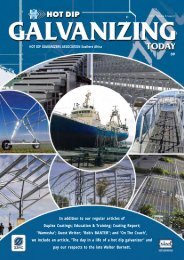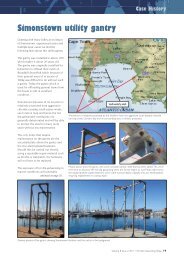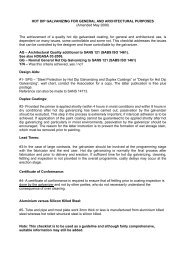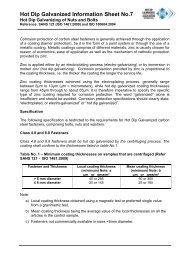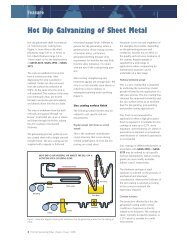Fasteners - hdgasa
Fasteners - hdgasa
Fasteners - hdgasa
You also want an ePaper? Increase the reach of your titles
YUMPU automatically turns print PDFs into web optimized ePapers that Google loves.
Duplex coatings<br />
Two different bus shelter types at the fabricators plant, prior to hot dip galvanizing.<br />
process and special care needs to be<br />
taken not to damage the paint in any<br />
way. If the paint is damaged the area<br />
must be sanded and re-sprayed.<br />
The base coat was an epoxy<br />
galvanizing primer called Epoxy<br />
Adprime 1 Base. The paint is supplied<br />
with a catalyst to initiate the<br />
hardening process and ensure that it<br />
dries correctly. A galvanizing primer is<br />
essential as it bonds to the galvanized<br />
steel unlike other paints. In addition,<br />
it prevents the paint from peeling and<br />
it also prevents water from penetrating<br />
the paint and accumulating<br />
underneath, forming bubbles.<br />
The next coat was an intermediate<br />
coat called Umeguard SX Base. This<br />
paint is also supplied with a catalyst<br />
to initiate the hardening process and<br />
The totem pole type of bus stop installed at<br />
one of the sites.<br />
ensure the paint dries correctly. The<br />
intermediate coat is an epoxy resin<br />
coating. The colour chosen for this<br />
coat was a light grey although it was<br />
originally going to be a red-brown. The<br />
darker colour was found to be<br />
problematic when the sun shone on<br />
the final coat, as the intermediate<br />
colour would show through. This was<br />
obviously unacceptable, therefore the<br />
decision to change the intermediate<br />
coat to the light grey was made.<br />
The final coat consisted of two<br />
different colours, one colour for the<br />
totem pole assemblies and the other<br />
colour for the rest of the bus shelter.<br />
The first items to be sprayed were the<br />
totem pole assemblies. These were<br />
sprayed with a paint called Uny Marine<br />
Base, supplied with a catalyst to<br />
initiate the hardening process and<br />
ensure the paint dried correctly. This is<br />
a polyurethane finishing coat with<br />
long lasting gloss retention. It is highly<br />
durable and is resistant to chemical<br />
damage.<br />
After the totem pole assemblies were<br />
painted, the rest of the assemblies<br />
were also sprayed with Uny Marine<br />
Base in a dark grey colour. The final<br />
coat for the shelters, excluding the<br />
totem pole assemblies, gave a stonechip<br />
effect finish. This top coating is<br />
beneficial in more than one way. It<br />
hides any slight imperfections in the<br />
paint that would normally be visible<br />
if a smooth finish was used and it<br />
gives a slightly thicker paint finish.<br />
Exeo was impressed with the look<br />
and asked for all the shelters to be<br />
sprayed with this finish.<br />
The paint was required to be a final<br />
thickness of between 280 and 350<br />
microns and was checked with a<br />
digital paint thickness tester. If it was<br />
found to be too thin, another coat was<br />
applied. The average thickness of the<br />
paint on the shelters throughout the<br />
project was about 320 microns.<br />
Once the spray painting was finished,<br />
the shelters were left to stand for 48<br />
hours in order for the paint to cure<br />
and harden properly<br />
Assembly<br />
As specified by the architects, all nuts<br />
and bolts used had to be high-tensile<br />
and hot dip galvanized. Two different<br />
sized nuts and bolts were used for the<br />
assembly of the shelters, M12 and M16.<br />
Galvazinc was used to repair the hot<br />
dip galvanized coating prior to<br />
painting.<br />
Full shelter installation<br />
The anchor bolt cages were also<br />
manufactured by Arand Engineering.<br />
M20 ready bar was cut to length and a<br />
cage was made to hold them in place.<br />
Two different types of cages were<br />
made. The first type had four bolts in a<br />
square formation, the other had only<br />
two anchor bolts.<br />
There was one cage with four anchor<br />
bolts and two cages with two anchor<br />
28 Hot Dip Galvanizing Today Volume 10 Issue 2 2013


